From Charleston to Morgantown, The Mountain State is home to several incredible birds. With 366 species observed on ebird, the rugged landscape and changing seasons in West Virginia provide for an amazing habitat. In this post we’ll review 30 of the most common and colorful birds in West Virginia along with some useful data on when and where to find them.
We sampled 5 years of aggregate data from ebird’s West Virginia checklists to compile easy to use statistics and graphs to assist in identifying each bird species. So whether you’re just watching the backyard bird feeder or venturing to birding hotspots like Greenbottom or Pricketts Fort – we’ll have you ready to start bird watching like a professional.
American Goldfinch
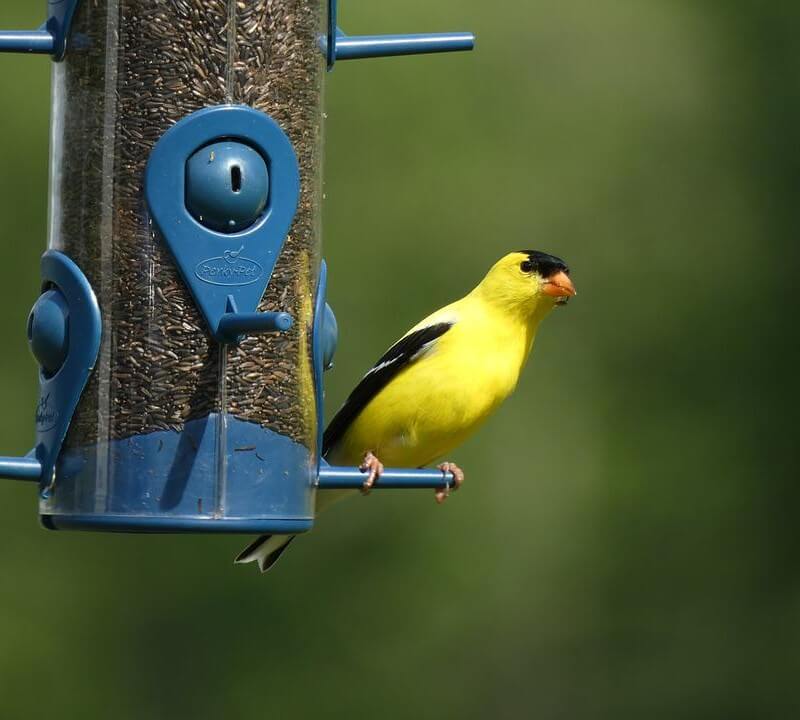
A small finch with a short tail, the American Goldfinch is widespread throughout North America.
- Carduelis tristis
- Size: 5″ (13cm)
- WV Checklist Frequency High: 61% in August
- WV Checklist Frequency Low: 25% in February
Identification and Color: A fan favorite at backyard feeders for its brilliant yellow color. A small, slim finch with a small bill and rounded wings. The back is black with white wing bars. Underparts are yellow with a black bill. The tail is white with black markings on the outer feathers.
Habitat and Behavior: The American Goldfinch nests and breeds in open woodlands, meadows, and fields. Commonly seen in gardens and parks. During the breeding season, the American Goldfinch is often seen in flocks. Known to hang upside down from branches while feeding. Typically nests late in the summer.
Diet: Strict vegetarian. The American Goldfinch feeds on tiny seeds, weeds and grasses. Enjoys nyjer and sunflower seeds. Rarely consumes insects.
American Robin
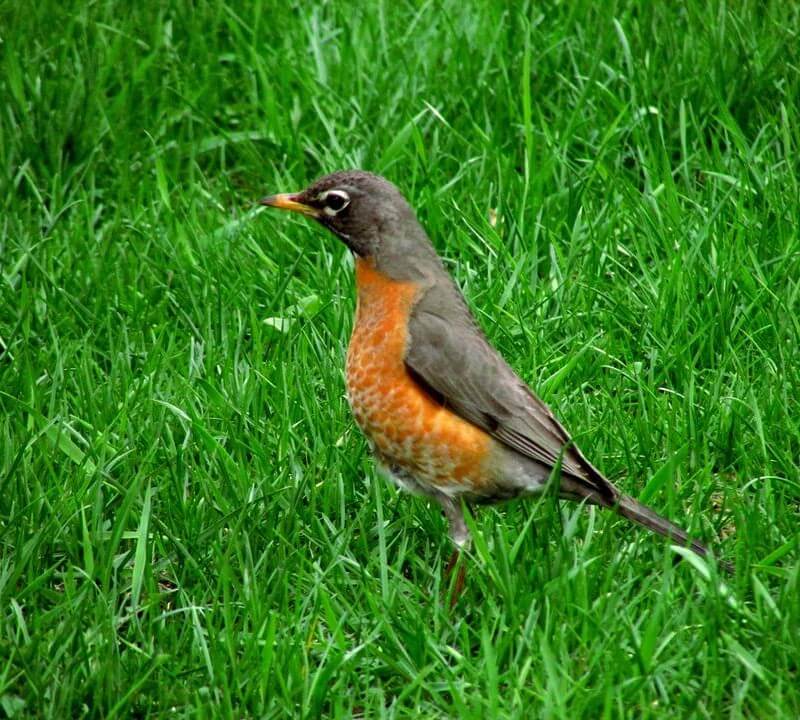
Abundant throughout the entire country and commonly a welcome indicator of spring in northern states. The American Robin is seen year-round in West Virginia.
- Turdus migratorius
- Size: 9-11″ (22.5-28cm)
- WV Checklist Frequency High: 69% in April
- WV Checklist Frequency Low: 16% in January
Identification and Color: Reddish-brown breast (almost looks pot-bellied) and grey back. The female usually has a lighter plumage than the male. Males have a darker black head.
Habitat and Behavior: The American Robin is found in open woodlands, gardens, and parks. It often forages for food on the ground cocking its head to the side in an effort to find worms. When it’s not eating, the American Robin can often be seen perched on a branch singing its cheerful song.
Diet: The American Robin feeds on insects, worms, berries, and fruits.
Barn Swallow

The Barn Swallow is a small common songbird that is often seen swooping in flight. Typically found in West Virginia during the summer months.
- Hirundo rustica
- Size: 7″ (17 cm)
- WV Checklist Frequency High: 31% in July
- WV Checklist Frequency Low: 0% in Winter
Identification and Color: Easily identified by its long forked tail. Has a shiny blue hood and back with orange underparts.
Habitat and Behavior: Found in fields and meadows, specifically for foraging. Can also be seen near lakes and ponds. These birds are attracted to barns and other buildings because they provide a safe place to build their nests. These birds are known for their aerial acrobatics and often perform flips and twists while flying.
Diet: The Barn Swallow feeds on insects, which it often catches in mid-air. Can also be seen skimming the water’s surface for a drink.
Blue Jay

Blue Jays are one of the most recognizable birds in North America. Not one of the “nicest” birds, but a ubiquitous sight in West Virginia backyards.
- Cyanocitta cristata
- Size: 11″ (28 cm)
- WV Checklist Frequency High: 76% in September
- WV Checklist Frequency Low: 37% in January
Identification and Color: Larger than a sparrow but smaller than a crow, with a characteristic blue plumage and white chest. Has a loud screeching call.
Habitat and Behavior: Blue Jays make their homes in woods and forests, but can also be found in urban areas. They are known for their loud calls, which can often be heard before the bird is seen. Blue Jays are not typically shy around humans and can often be attracted to backyard bird feeders. However, Blue Jays can be very aggressive towards other birds and animals so proceed with caution.
Diet: Blue Jays are omnivorous, meaning they will eat both plants and animals. Their diet includes acorns, nuts, seeds, fruits, and insects.
Carolina Chickadee

The Carolina Chickadee is a year-round resident of West Virginia.
- Poecile carolinensis
- Size: 5.5″ (14 cm)
- WV Checklist Frequency High: 35% in April
- WV Checklist Frequency Low: 15% in July
Identification and Color: Their black colored head is separated by white cheek patches. Darker grey wings and lighter grey to white underparts. A small and rounded bird with a thick but short bill. Both males and females will be around 4-5 inches in length.
Habitat and Behavior: The Carolina Chickadee is found all over a large portion of the southeast and is a permanent resident there. Prefers to be in forested areas but can also be found around suburban locations. Can flock together but will usually eat separately. Forages mostly by hopping around on trees.
Diet: The Carolina Chickadee eats a variety of insects, seeds, and berries.
Carolina Wren
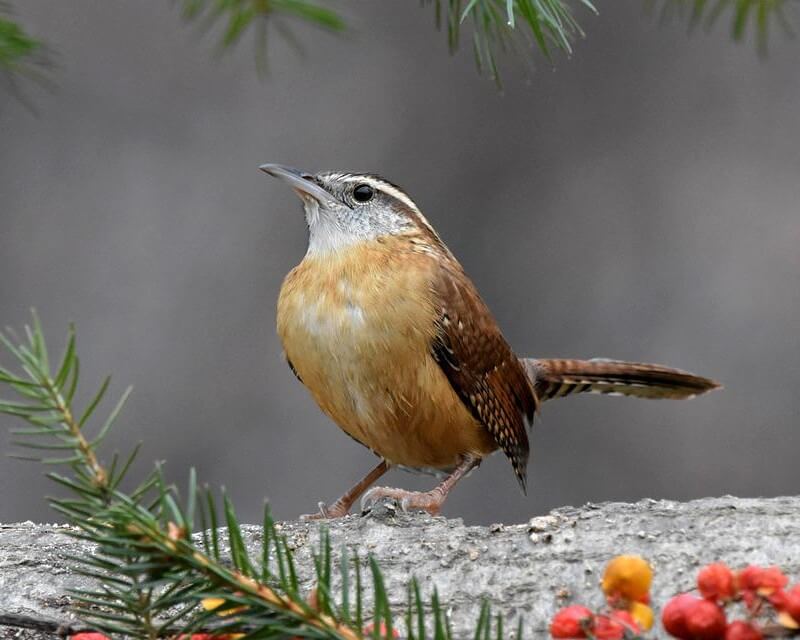
The Carolina Wren is a common bird in eastern North America and is seen year-round in West Virginia.
- Thryothorus ludovicianus
- Size: 5.5″ (14 cm)
- WV Checklist Frequency High: 52% in September
- WV Checklist Frequency Low: 33% in June
Identification and Color: Small, slightly chunky with reddish-brown feathers and a rusty gold/yellowish belly. The Carolina wren is known for its loud, distinctive rollicking call.
Habitat and Behavior: Very curious and active, they are often seen moving around in low areas searching for food. These birds build their nests in trees or shrubs.
Diet: The Carolina Wren diet consists mostly of insects and spiders from trees, but they will also eat fruit, berries, and seed.
Chimney Swift

The Chimney Swift is a common resident of urban areas in West Virginia during the summer.
- Chaetura pelagica
- Size: 5″ (13 cm)
- WV Checklist Frequency High: 21% in July
- WV Checklist Frequency Low: 0% in Winter
Identification and Color: A dark brown swift with some pale gray around the throat. The Chimney Swift has been described as a “cigar with wings.” Wings are long and appear rounded while soaring through the sky.
Habitat and Behavior: Found in the eastern part of North America, The Chimney Swift receives its name for nesting in chimneys or building shafts. Often seen in residential areas soaring high in search of food or darting down to a large pool of water for a drink.
Diet: The Chimney Swift mainly enjoys insects, often catching them in flight. Will skim the water for a drink much like a Swallow.
Common Grackle
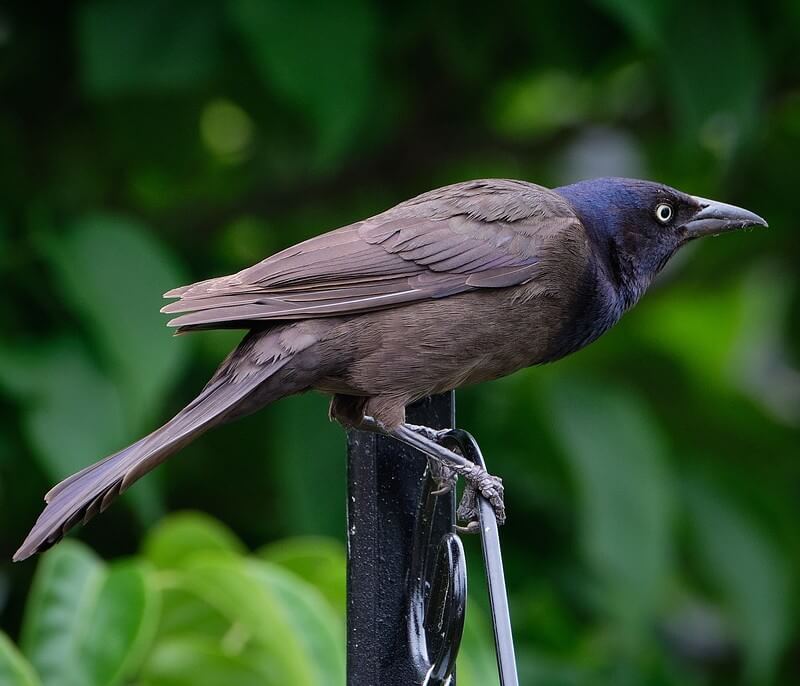
The Common Grackle is abundant through most of central and eastern North America. One of the most common backyard birds in West Virginia.
- Quiscalus quiscula
- Size: 12.5″ (32 cm)
- WV Checklist Frequency High: 33% in May
- WV Checklist Frequency Low: 1% in Winter
Identification and Color: Easily identified by their glossy black feathers and yellow eyes, the Common Grackle also has a curved beak. Female is a bit smaller and less shiny than the male.
Habitat and Behavior: Common grackles typically live in open areas such as fields and marshes. Usually forages in flocks. Very common in towns and cities. Known for being aggressive towards other birds.
Diet: The Common Grackles is omnivorous. Grains, seed, and insects are all favorites. Will also scavenge through garbage for food.
Dark-eyed Junco

The Dark-eyed Junco is a small, sparrow-like bird that is most often seen in West Virginia during the winter months.
- Junco hyemalis
- Size: 6″ (15 cm)
- WV Checklist Frequency High: 39% in February
- WV Checklist Frequency Low: 2% in August
Identification and Color: Rounded dark head and eyes. Charcoal back and white breast.
Habitat and Behavior: Enjoys a variety of wooded habitats through Canada and the northern United States. Dark-eyed Juncos are typically found in open woods, forest edges, weedy fields, and backyards. In winter they often form flocks and can be seen feeding on the ground beneath bird feeders.
Diet: Dark-eyed Juncos eat mostly insects and seeds.
Downy Woodpecker
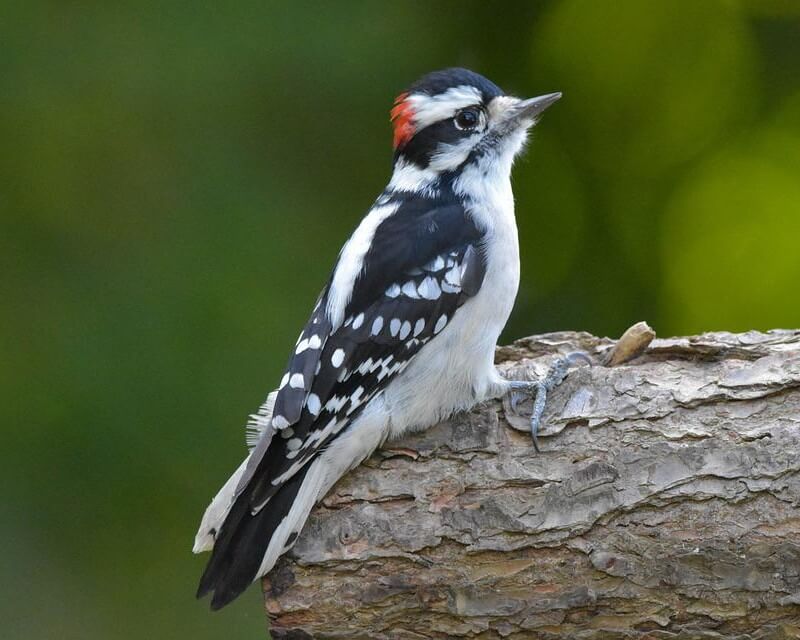
The Downy Woodpecker can be seen year-round in West Virginia.
- Picoides pubescens
- Size: 6″ (15 cm)
- WV Checklist Frequency High: 44% in February
- WV Checklist Frequency Low: 19% in May
Identification and Color: Adult Downies are black and white, with a black back, white belly, and a small patch of red on the back of the head. They have a short bill and a barred tail.
Habitat and Behavior: Downy Woodpeckers live in forests, woodlands, orchards, and suburban areas. They are year-round residents in most of their range. They forage on tree trunks and branches, using their bills and barbed tongue to peck at bark to find food.
Diet: Downies feed on insects, spiders, berries, and nuts. Downies sometimes store food by caching it in cracks in trees or other hidden spots. Can be spotted at seed and suet feeders.
Eastern Bluebird

Eastern Bluebirds can be seen year-round in West Virginia.
- Sialia sialis
- Size: 7″ (18 cm)
- WV Checklist Frequency High: 26% in October
- WV Checklist Frequency Low: 14% in January
Identification and Color: Easily identified by its flashy blue plumage and rusty breast.
Habitat and Behavior: The eastern bluebird typically nests in tree cavities, but it will also use man-made nesting boxes. It is an active bird often seen perching on fences waiting to chase after insects.
Diet: Consists mainly of insects, but it will also eat berries and fruit
Eastern Phoebe
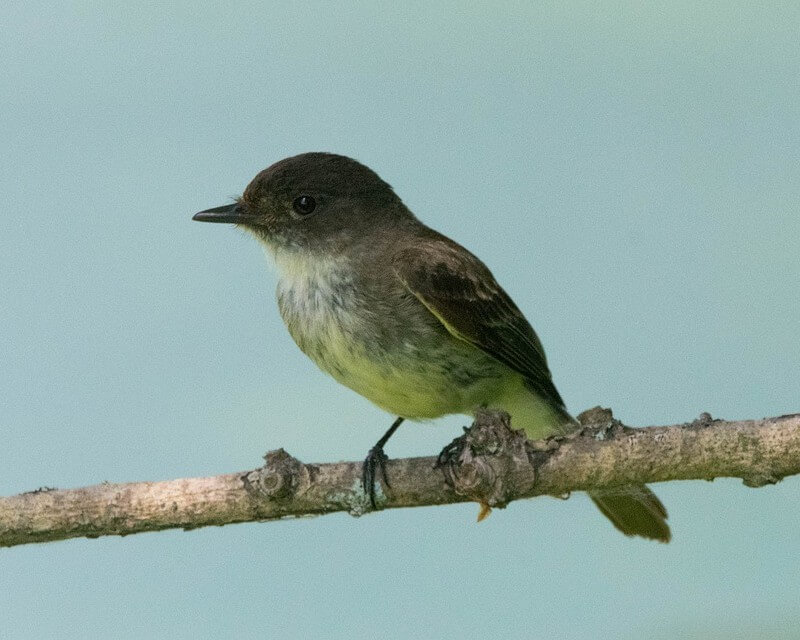
The Eastern Phoebe is most often seen in West Virginia during the spring and fall months.
- Sayornis phoebe
- Size: 6″ (15 cm)
- WV Checklist Frequency High: 35% in September
- WV Checklist Frequency Low: 2% in Winter
Identification and Color: A dark grey to a black head and light grey top, wings, and tail. The underparts are a white to greyish color. In fall a pale yellow around the belly can be seen with some faint white on the wing’s edges. A plump, rounded-looking bird with a large head. They have a short, thin bill.
Habitat and Behavior: Located in the eastern half of the US and parts of Canada. They migrate early in the spring and late in the fall. Prefers open areas such as fields, forest edges, or riverside areas. Active birds that will perch low and frequently fly out to catch insects.
Diet: Insects such as bees, flies, and grasshoppers are all favorites. Will also eat some berries during the winter months.
Eastern Towhee

The Eastern Towhee is most often seen in West Virginia during the summer months.
- Pipilo erythrophthalmus
- Size: 9″ (23 cm)
- WV Checklist Frequency High: 51% in April
- WV Checklist Frequency Low: 6% in January
Identification and Color: Males and females have reddish brown and white underparts with some white on their wings. However, males have a black top and females have brown on top. These birds will be between 6 and 9 inches in length. They have thick, triangular bills.
Habitat and Behavior: The Eastern Towhee is mainly found in the eastern half of the states. Northern birds will migrate and southern birds are permanent residents. Prefers undergrowth, thickets, and brushy areas. Mostly on the ground to forage but will also be in shrubs or low trees which is where you will most likely be able to see this bird.
Diet: Berries, seeds, and insects make up their diets. May also eat a small lizard or snake on occasion.
European Starling
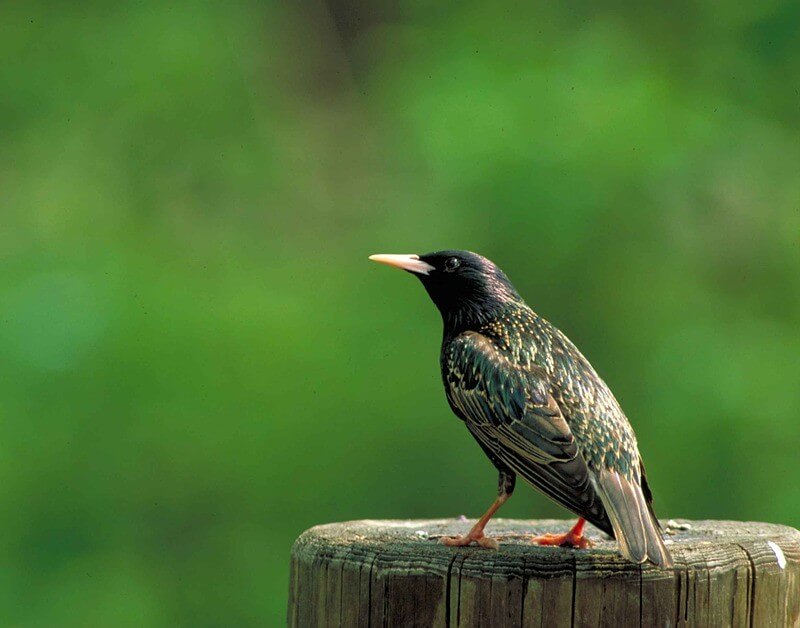
The European Starling is native to Europe but was introduced to North America in the late 1800’s. Considered an invasive species, they are one of the most common backyard birds in West Virginia.
- Sturnus vulgaris
- Size: 8.5″ (22 cm)
- WV Checklist Frequency High: 41% in April
- WV Checklist Frequency Low: 21% in August
Identification and Color: Small, stocky black birds with glossy feathers and a slender pointed bill. Speckled with white spots.
Habitat and Behavior: European starlings can be found in woods, fields, and other open areas. They often build their nests in trees or holes in buildings. European starlings are also known for their elaborate vocalizations, often imitating the sounds of other birds.
Diet: European starlings are opportunistic eaters and will feed on a variety of insects, fruits and seeds.
Gray Catbird
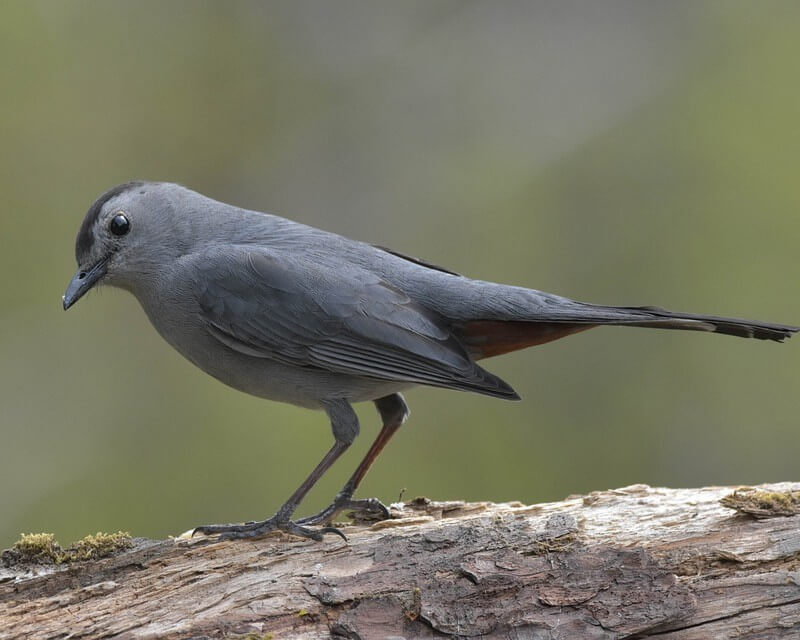
The Gray Catbird is a small songbird commonly seen in West Virginia during the summer months.
- Dumetella carolinensis
- Size: 8.5″ (22 cm)
- WV Checklist Frequency High: 40% in May
- WV Checklist Frequency Low: 1% in Winter
Identification and Color: A slender gray bird with a black cap and tail. Gray Catbirds are named for their call, which sounds like a cat meowing.
Habitat and Behavior: Gray Catbirds are found in wooded areas, often near streams or wetlands. Likes thickets and brushy shrubs. They are shy birds that do not often come into contact with humans. Gray Catbirds build cup-shaped nests out of leaves, twigs, and grasses.
Diet: Mainly insects in the spring and summer. Primarily berries and seed in the winter.
House Finch
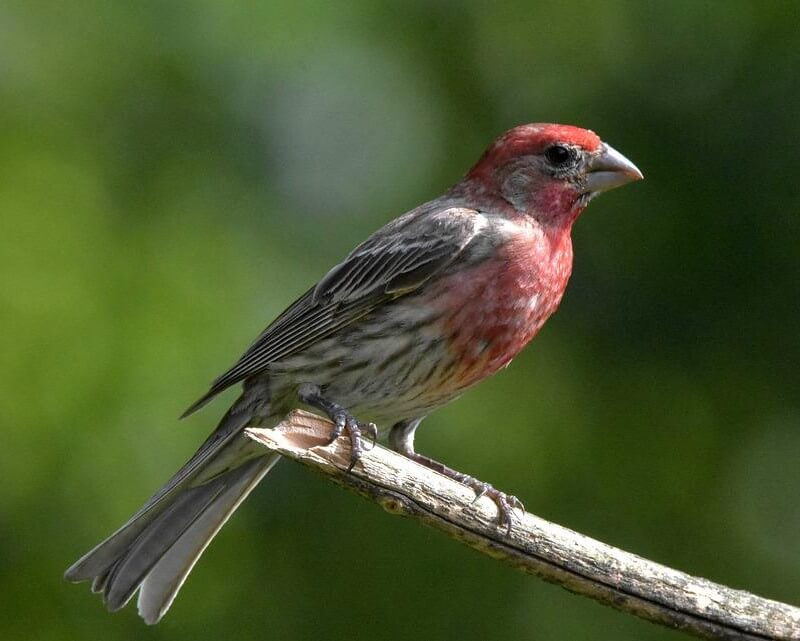
The House Finch is a common bird across North America, seen year-round in West Virginia.
- Carpodacus mexicanus
- Size: 5″ (13 cm)
- WV Checklist Frequency High: 31% in February
- WV Checklist Frequency Low: 16% in September
Identification and Color: Fairly small, measuring only about 5-6 inches long. House Finches are relatively easy to identify thanks to their characteristic red plumage near the eyes and throat. Males are typically redder than females, but both genders have distinctive streaks on their breast and belly.
Habitat and Behavior: House Finches are found in a variety of habitats, including woods, gardens, and open fields. A rather social bird that often travels in flocks. Can often be seen perching on power lines or fences in suburban areas.
Diet: House Finches are primarily seed eaters, but they will also consume insects and fruit on occasion.
House Sparrow
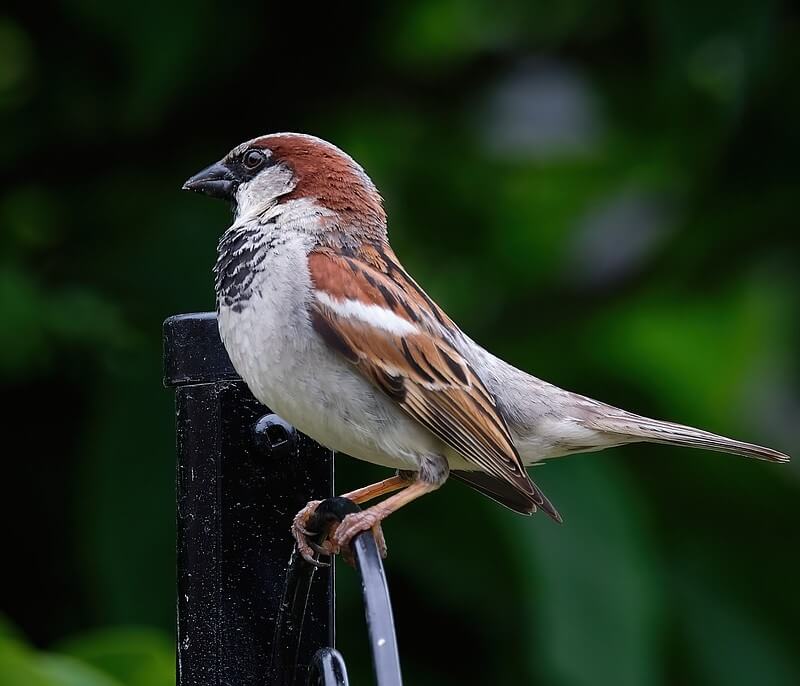
One of the most common backyard birds in West Virginia. The House Sparrow is seen year-round.
- Passer domesticus
- Size: 6″ (15 cm)
- WV Checklist Frequency High: 25% in December
- WV Checklist Frequency Low: 13% in September
Identification and Color: A small plump bird with brown feathers and a grayish-plain breast. They have a black stripe on their face that extends from their bill to their throat. Wings are streaked with black and white.
Habitat and Behavior: Found in open areas with some trees nearby, such as farmland, parks, and suburban neighborhoods. They build their nests in holes in tree trunks or in man-made structures such as gutters, light fixtures, and nest boxes. House Sparrows are social birds that often form large flocks. You won’t be surprised to see them downtown near restaurants with outdoor seating!
Diet: House Sparrows eat mostly seeds and grains, but will also eat insects, berries, and other fruits. Happy to pick up crumbs and left over human food where available.
Mourning Dove
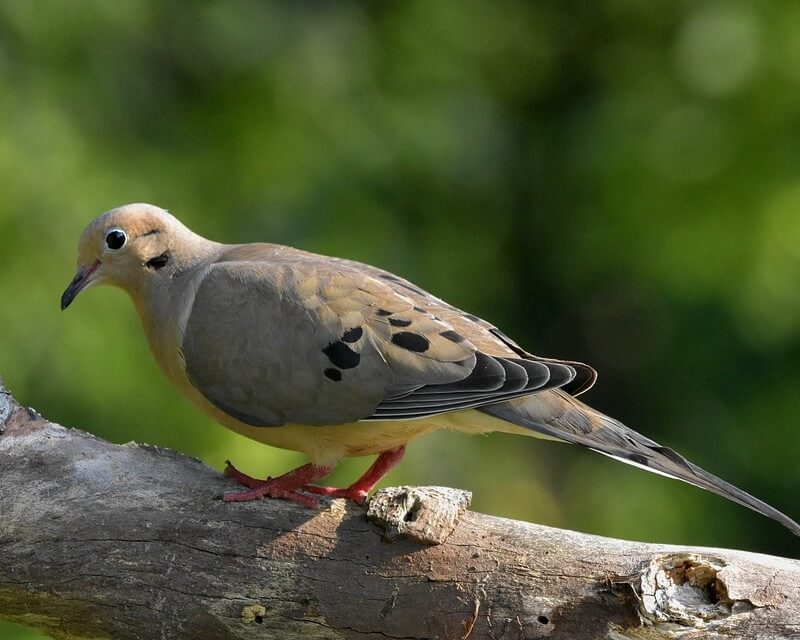
Mourning Doves are one of the most common birds in North America, and they can be found in a variety of habitats throughout West Virginia.
- Zenaida macroura
- Size: 12″ (30 cm)
- WV Checklist Frequency High: 54% in August
- WV Checklist Frequency Low: 27% in November
Identification and Color: These slender birds have long, pointed tails and a tiny head. Brown and pale gray plumage with darker streaks on the wings and back.
Habitat and Behavior: Mourning Doves are relatively quiet birds, but they can often be heard cooing softly. Mourning Doves typically nest in trees, but they will also use man-made structures such as window ledges and gutters.
Diet: The Mourning Dove primarily eat seeds, but they will also eat insects and berries
Northern Cardinal
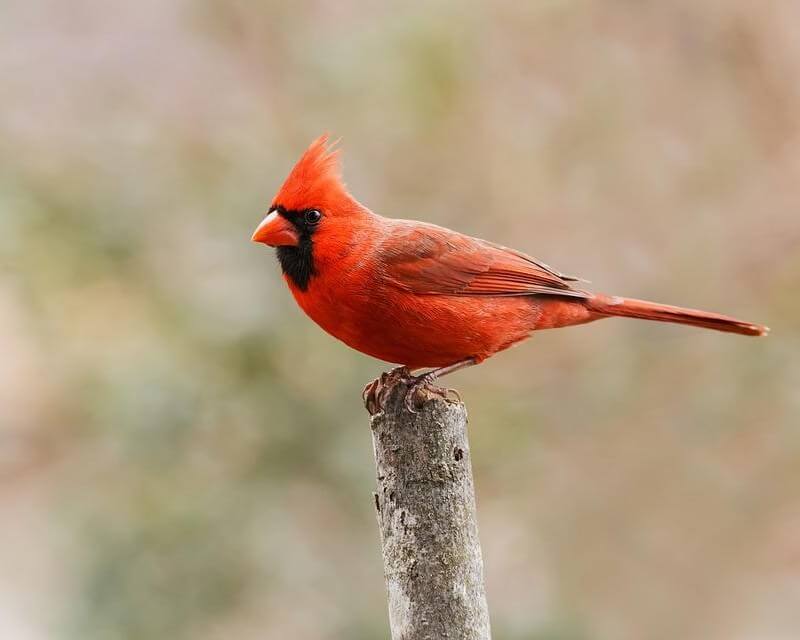
The State bird of West Virginia. The Northern Cardinal is a beautiful red bird residing in West Virginia year-round.
- Cardinalis cardinalis
- Size: 9″ (22.5 cm)
- WV Checklist Frequency High: 66% in April
- WV Checklist Frequency Low: 42% in November
Identification and Color: A very common medium-size songbird with a pointed crest and long tail. Cardinals are easily identified by their bright red plumage, making them one of the most recognizable birds in North America. The Northern Cardinal is so popular it has been named the state bird by seven states – more than any other bird.
Habitat and Behavior: Cardinals are typically found near wooded areas but can be seen in a variety of places such as suburban backyards and parks. These birds are very social creatures, and they often form pairs that mate for life.
Diet: Northern Cardinals are up for anything and will visit most bird feeders. A rather varied diet that consists of insects, fruit, berries and seeds.
Northern Flicker
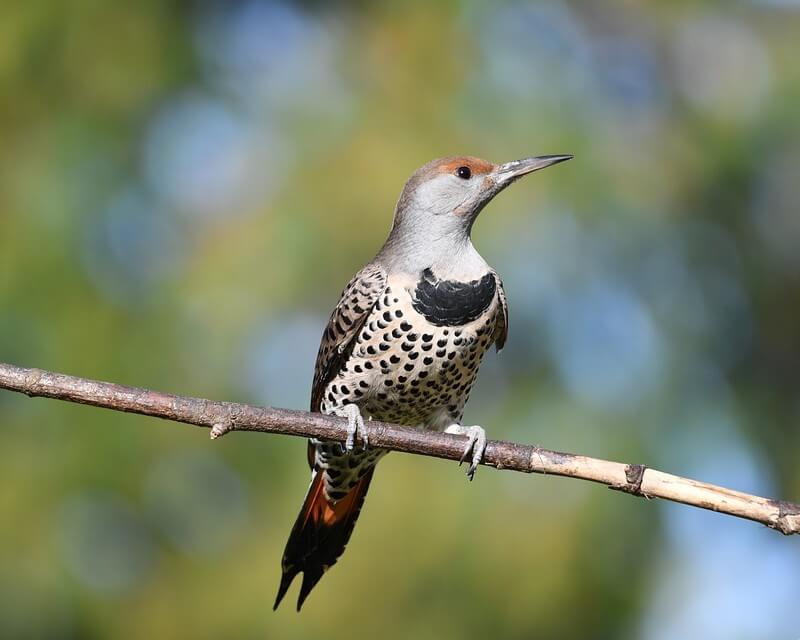
The Northern Flicker is seen year-round in West Virginia.
- Colaptes auratus
- Size: 12″ (30 cm)
- WV Checklist Frequency High: 31% in October
- WV Checklist Frequency Low: 10% in February
Identification and Color: A fairly common large woodpecker, but size is where the similarities to other woodpeckers end. The male Northern Flicker is unique with a brown back, black bars and spotted breast. All North American Flickers have white rumps. There are also two different color groups of Northern Flickers – Yellow-shafted and Red-shafted. Yellow-shafted flickers have yellow underwings. Red-shafted flickers have reddish pink underwings.
Habitat and Behavior: Northern Flickers are hole-nesting birds, often making a home in a dead tree. Can be seen hopping around the ground while foraging or latched onto a tree eyeing a spot to search for food.
Diet: Northern Flickers mainly eat insects off the ground, but will also eat berries and nuts.
Northern Mockingbird
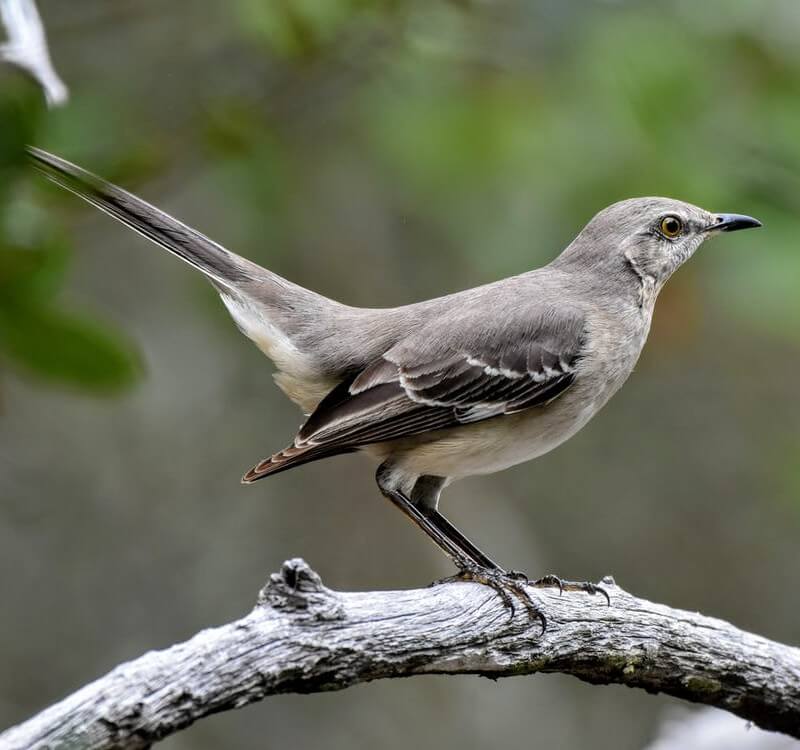
The Northern Mockingbird is a common sight in West Virginia, known for its distinctive song and plumage.
- Mimus polyglottos
- Size: 10″ (25 cm)
- WV Checklist Frequency High: 24% in October
- WV Checklist Frequency Low: 11% in September
Identification and Color: Northern Mockingbirds are mostly gray in color with white patches on the wings and tail. They have a long black bill and yellow eyes.
Habitat and Behavior: Northern Mockingbirds are found in open habitats such as parks, woods edges, and suburban backyards. They are active throughout the day and are known for their territorial behavior, often chasing away other birds or small animals that come too close to their nest. The Northern Mockingbird is a bit of a joker with its constant imitating of other bird calls.
Diet: Northern Mockingbirds mainly eat insects, but will also eat fruits and berries in the winter.
Purple Martin

The Purple Martin can be seen during summer in West Virginia.
- Progne subis
- Size: 8″ (20 cm)
- WV Checklist Frequency High: 7% in July
- WV Checklist Frequency Low: 0% in Winter
Identification and Color: Males have a shimmery dark blue head, front, and top of the body. Their wings and tails are brown and black. Females have duller colors with more grey and white underparts. They have short tails that are forked and long wings that taper out. They have stout bills with slight hooks to them.
Habitat and Behavior: The Purple Martin is a migratory bird that spends spring and summer in the midwest and the eastern United States. They fly long distances south during their migration. Will nest together with many others. They forage midair and spent the majority of their time high up.
Diet: Insects are the bulk of their diet. Winged insects like wasps, dragonflies, and moths are favorites.
Red-bellied Woodpecker

The Red-bellied Woodpecker is a small to medium-sized woodpecker seen in West Virginia year-round.
- Melanerpes carolinus
- Size: 9″ (23 cm)
- WV Checklist Frequency High: 44% in October
- WV Checklist Frequency Low: 21% in July
Identification and Color: The Red-bellied woodpecker gets its name from the vaguely-visible reddish color on its belly, which is typically only seen when the bird is perched. They have a black and white striped back, white underparts, and a red nape.
Habitat and Behavior: The Red-bellied Woodpecker is a non-migratory bird, meaning it will stay in the same general area year-round. Forages for insects in trees or catches them in air. Can dominate other smaller woodpeckers and birds at feeders.
Diet: Consists mainly of insects and other invertebrates. Will also eat seeds, nuts and fruit.
Red-winged Blackbird
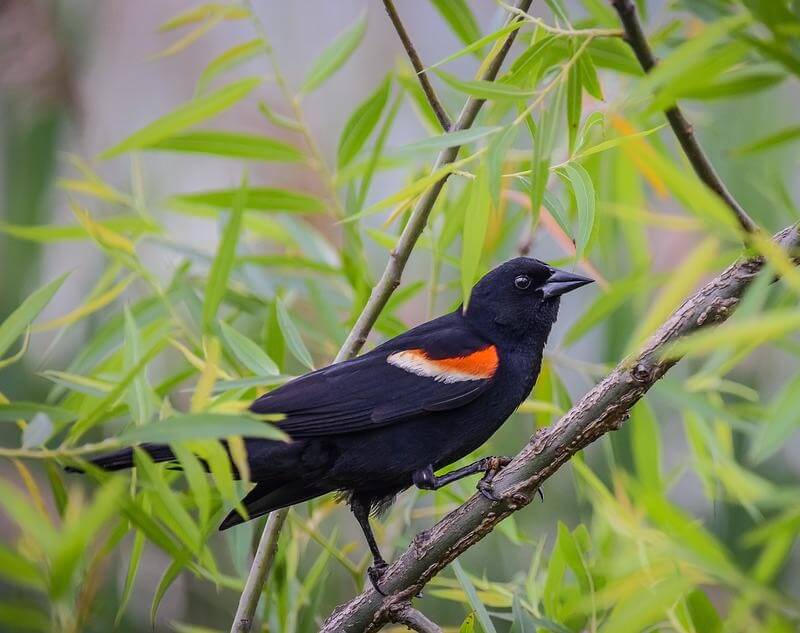
Mainly seen in the summer for most of the state. The Red-winged Blackbird is a year-round resident of West Virginia.
- Agelaius phoeniceus
- Size: 8.5″ (22 cm)
- WV Checklist Frequency High: 44% in April
- WV Checklist Frequency Low: 2% in January
Identification and Color: A small black bird with a striking appearance. The male has black feathers and a red patch on each wing, while the female is mostly dark brown with vertical streaks.
Habitat and Behavior: These birds are found in open areas such as marshes, meadows, and fields. Often seen near water, where they build their nests. Red-winged Blackbirds are social birds and often form large flocks.
Diet: The Red-winged Blackbird diet consists of insects, spiders, and other small invertebrates. Will also eat seeds, fruits, and berries.
Ruby-throated Hummingbird

The Ruby-throated Hummingbird can be seen during the warmer months in West Virginia.
- Archilochus colubris
- Size: 3.5″ (8 cm)
- WV Checklist Frequency High: 38% in September
- WV Checklist Frequency Low: 0% in Winter
Identification and Color: The Ruby-throated Hummingbird has a brilliant green color on the tops of their heads and bodies and a grey to white underpart. The males have a red throat that can appear dark in poor lighting. A small bird between 2 and 3.5 inches in length. They also have very short wings. A long, slender slightly curved bill.
Habitat and Behavior: In the summer they are found throughout the midwest and the eastern United States but almost all leave for the winter. The Ruby-throated Hummingbird prefers open woodlands, meadows, and gardens. They can fly very fast and will forage from flowers or feeders.
Diet: Mostly nectar from flowers but will eat some small insects.
Song Sparrow
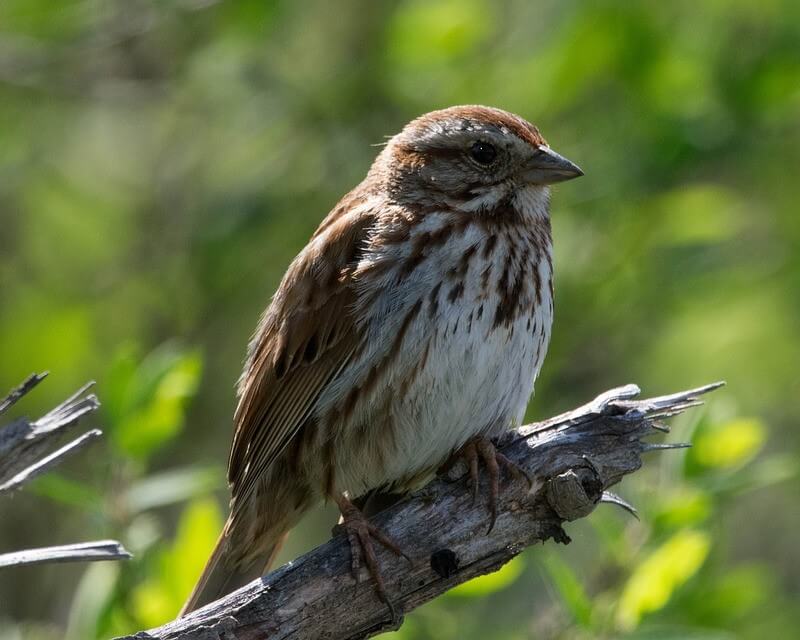
The Song Sparrow is a small bird that is commonly found year-round in West Virginia.
- Melospiza melodia
- Size: 6″ (15 cm)
- WV Checklist Frequency High: 56% in March
- WV Checklist Frequency Low: 27% in September
Identification and Color: The Song Sparrow is brown and gray in color with streaks on its breast and a grayish-brown back. Gets its name from its loud melody.
Habitat and Behavior: Can be found in a variety of habitats including forests, grasslands, and wetlands. The Song Sparrow is a relatively shy bird, but will happily visit bird feeders if food is available.
Diet: Song Sparrows primarily eat insects, but will also eat seeds and berries.
Tree Swallow

The Tree Swallow is a common resident of West Virginia during the summer.
- Tachycineta bicolor
- Size: 6″ (15 cm)
- WV Checklist Frequency High: 26% in May
- WV Checklist Frequency Low: 0% in Winter
Identification and Color: Adult males have blue-green on top of their heads and on top of their bodies. They have a white throat and underparts. The edges of the wings are black. Females are similar but are brown whereas males are blue-green. They both have darker-colored areas around their eyes. Long, pointed wings, and a short, squared tail.
Habitat and Behavior: Spends the breeding season in the far north and winters in the south usually along a coastline. Prefers open areas in fields or wetlands. Forages in the air or over water.
Diet: Feeds on insects like flies, winged ants, and some spiders. Will also eat some berries.
Tufted Titmouse
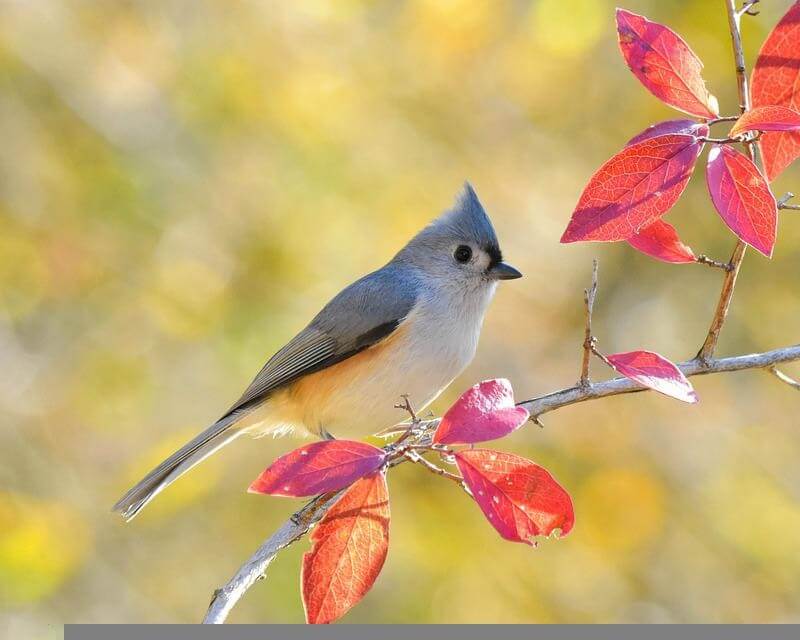
The Tufted Titmouse is a small songbird native to the eastern United States. Found year-round in West Virginia.
- Baeolophus bicolor
- Size: 6″ (15 cm)
- WV Checklist Frequency High: 51% in February
- WV Checklist Frequency Low: 27% in August
Identification and Color: A small songbird, adults have gray upper parts and whitish under parts. A distinctive tuft of black feathers on the head with dark eyes.
Habitat and Behavior: Tufted Titmice are non-migratory birds and can be found in woods, gardens, and parks throughout the state. Tufted Titmice are social birds that often form flocks with other titmice, chickadees, and nuthatches. Has a distinct “peter-peter-peter” call.
Diet: Likes to snag insects from bark or foliage. The Tufted Titmouse also consumes seeds, fruits, and berries.
White-breasted Nuthatch

The White-breasted Nuthatch can be found year-round in West Virginia.
- Sitta carolinensis
- Size: 6″ (15 cm)
- WV Checklist Frequency High: 42% in February
- WV Checklist Frequency Low: 19% in May
Identification and Color: A stocky short-tailed bird. Has a black cap above an all white face and breast. Blueish upper parts.
Habitat and Behavior: The White-breasted Nuthatch can be found in forests, woodlands, and parks. Known for its acrobatic abilities, it can easily move up, down, and sideways on trees.
Diet: The White-breasted Nuthatch feeds on insects, spiders, and small nuts. Relies on seeds in the winter and will often cache them in a crevice for a later date.
White-throated Sparrow
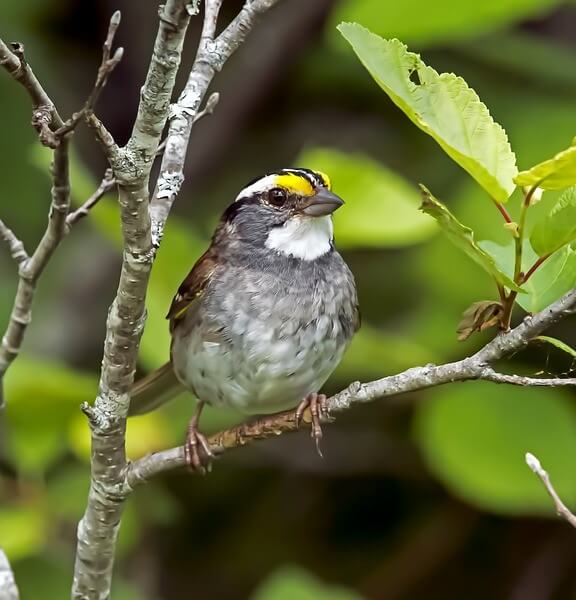
The White-throated Sparrow is a common bird during spring and fall in West Virginia.
- Zonotrichia albicollis
- Size: 7″ (18 cm)
- WV Checklist Frequency High: 33% in December
- WV Checklist Frequency Low: 1% in Summer
Identification and Color: A small sparrow with a brown back, white belly, and yellow spot between eyes and bill.
Habitat and Behavior: The White-throated Sparrow can be identified by its song which is often described as “oh sweet Canada-Canada-Canada.” The White-throated Sparrow is a shy bird that is often seen hopping through brushy thickets or heavily wooded areas.
Diet: Mainly insects. Also fond of seeds and berries.
Conclusion
West Virginia is home to a wide variety of backyard birds. From small songbirds to large waterfowl, the state offers a great opportunity to observe and appreciate the beauty of nature. With a little bit of effort, it is possible to attract a variety of birds to your backyard, providing hours of enjoyment and a chance to learn more about the birds of the area. Be sure to check out our other articles about birds in West Virginia:
Remember to keep that feeder full and have your checklist ready! Before you go, take a moment to review some of our favorite West Virginia birding resources:






